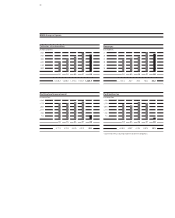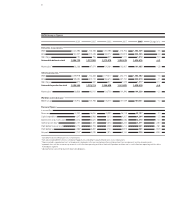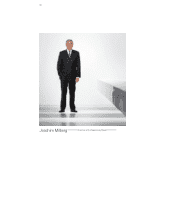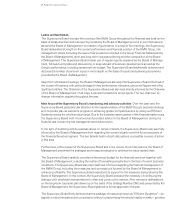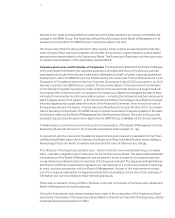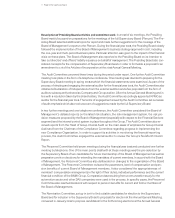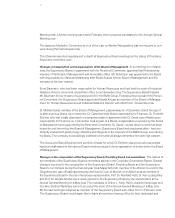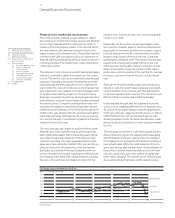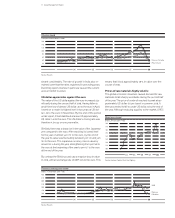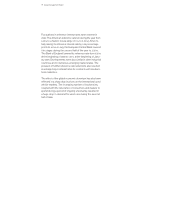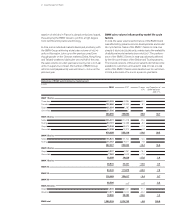BMW 2008 Annual Report Download - page 15
Download and view the complete annual report
Please find page 15 of the 2008 BMW annual report below. You can navigate through the pages in the report by either clicking on the pages listed below, or by using the keyword search tool below to find specific information within the annual report.
16
14 Group Management Report
14 A Review of the Financial Year
16 General Economic Environment
20 Review of Operations
42 BMW Stock and Bonds
45 Disclosures pursuant to § 289 (4)
and § 315 (4) HGB
47 Financial Analysis
47 Internal Management System
49 Earnings Performance
51 Financial Position
52 Net Assets Position
55 Subsequent Events Report
55 Value Added Statement
57 Key Performance Figures
58 Comments on BMW AG
62 Risk Management
68 Outlook
Financial crisis reaches the real economy
The world economy suffered a major setback in . In
the period up to summer the primary causes were the high
prices of raw materials and the consequences of the
re-
cession on the US property market. In the second half of
the year, however, the downturn worsened due to the
massive impact of the financial crisis. The problem was not
confined to the USA, but caused a crisis of confidence on
financial markets worldwide as well as a massive reduction
in lending volumes. The situation led to major disruptions
in the real economy.
The downturn in the US economy, which had already begun
mid-, continued to gather momentum over the course
of . The decline in prices for residential properties and
cutbacks in housing construction
investments worsened
during the year and there was still no
end in
sight by the
end of . The crisis of confidence on the financial mar-
kets triggered by loan defaults on
house mortgages went
on to have a far-reaching impact on the real economy.
American consumers in particular, who had generally been
quite willing to consume in recent years, became extremely
reluctant to spend. Companies increased their level of in-
vestment only slightly in . Only foreign trade volumes
profited from the weakness of the US dollar through to the
middle of the year, allowing the
US
current account deficit
to be reduced further. Although the US economy grew by
. over the full year, it nevertheless registered a downturn
towards the end of the year.
The euro zone was also unable to avoid the effects of the
financial crisis. Since summer , its performance has
been significantly weaker than in preceding years. Only a
very small increase was registered in the area of private
consumer spending. The main aggravating factors were
sharp price rises during the first half of the year and the pe-
tering out of positive developments on the job markets
during the second half of the year. Companies were ex-
tremely reluctant to invest and export figures fell from sum-
mer onwards in the wake of the global downturn, causing
the euro zone current account balance to drop into the
negative zone. Overall, the euro zone recorded a growth
of only . in .
In Germany too, the positive growth rate began to slide
from summer onwards. Exports, which had largely been
responsible for economic growth in recent years, ceased
to be the driving force for the economy when even they
began to drop towards the end of the year. Consumer
spending also remained weak. The positive impetus gen-
erated by the employment market right up to the end
of the year was not enough to relieve consumers of their
sense of uncertainty. It was only because of the robust
performance at the beginning of the year that the German
economy could record a growth rate of . for the full
year.
Although the new EU member states were still growing
robustly in , the growth rates registered were signifi-
cantly lower than in the previous year. This applied both
to domestic demand and to exports. The current account
deficits in these countries deteriorated noticeably.
It was originally thought that the Japanese economy
would only be marginally affected by the financial crisis.
As a result of the global downturn and the appreciation
of the yen, however, Japan too felt the knock-on effects
of the financial crisis, with recent export figures even
showing negative trends. Domestic demand also
weak-
ened perceptibly. As a result economic output decreased
by . .
The emerging economies of Latin America and Eastern
Asia continued to register the fastest growth rates along
with the Eastern European markets. Here too, however,
the negative factors outweighed the positive, resulting in
lower growth rates. While the credit markets in those re-
gions were far less affected than those of the industrial na-
tions, these countries were nevertheless hit by the finan-
cial crisis, particularly due to the outflow of capital and
lower export demand. The growth rate in China slowed
down, albeit still at a high level, and the export surplus
General Economic Environment
Exchange rates compared to the Euro
(Index: December = )
150
140
130
120
110
100
90
04 05 06 07 08
Source: Reuters
British Pound
Japanese Yen
US Dollar


